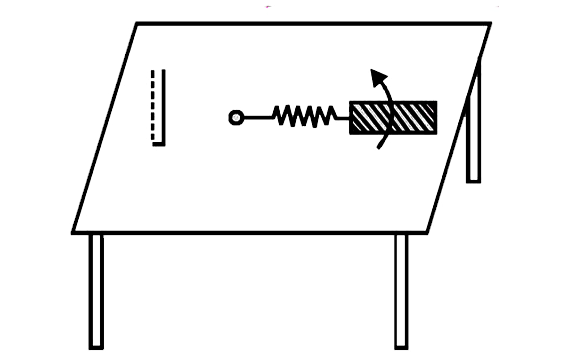(i) A rod length l ,is moved horizontally with a uniform velocity v in a direction perpendicular to its length through a region in which a uniform magnetic field is acting vertically downward. Derive the expression for the emf indunced across the ends of the rod.
(ii) How does one understand this motional emf by involving the Lorentz force acting on the free charge carriers of the conductor ? Explain.
Consider a straight conductor moving with velocity v and U - shaped conductor placed in perpendicular magnetic field as shown in the figure. Let conductor shifts from ab to a.b. in time dt, then change in magnetic flux,

dϕ=B×change in area=B×(areaa.b.ba)
=B×(l×vdt)
∴dϕdt=Bvl
∴Induced emf,|e|=dϕdt=Bvl
When a conductor moves through a region of field, all of free electrons of conductor experience a lorentz forece in same direction as they all are having a same velocity component F=e(v×B). This force shifts free electrons to one end of conductor and in this way an emf is generated.
Similar Questions
(a) A rod of length l is moved horizontal with a uniform velocity v in a direction perendicular to its length through a region in which a uniform magnetic field is acting vertically downward. Derive the expression for the emf induced across the end of the rod.
(b) How does one understand this motional emf by invoking the Lorentz force acting on the free charge carriers of the conductor? Explain.
View Solution(a) A rod of length is moved horizontally with a uniform velocity 'v' in a direction perpendicular to its length through a region in which a uniform magnetic field is acting vertically downward. Derive the exprwession for the emf induced across the ends of the rod. (b) How does one understand this motional emf by invoking the Lorentz force on the free charge carries of the condutor ? Explain.
View Solution
Knowledge Check
A metal rod moves at a constant velocity in a direction perpendicular to its length. A constant, uniform magnetic field exists in space in a direction perpendicular to the rod as well as its velocity. Select the correct statements(s) from the following
AThe entire rod is at the same electric potential.BThere is an electric field in the rod.CThe electric potential is highest at the centre of the rod and decreases towards its ends.DThe electric potential is lowest at the centre of the rod, and increases towards its ends.A metallic rod of length 'l' is tied to a string of length 2l and made to rotate with angular speed w on a horizontal table with one end of the string fixed. If there is a vertical magnetic field 'B' in the region, the e.m.f. Induced across the ends of the rod is
 A2Bωl22B3Bωl22C4Bωl22D5Bωl22
A2Bωl22B3Bωl22C4Bωl22D5Bωl22
A metallic rod of length l is moved perpendicular to its length with velocity v in a magnetic field →B acting perpendicular to the plane in which rod moves. Derive the expression for the inducced emf.
View SolutionA conducting rod of unit length moves with a velocity of 5m/s in a direction perpendicular to its length and perpendicular to a uniform magnetic field of magnitude 0.4T. Find the emf induced between the ends of the stick.
View SolutionA conducting rod of unit length moves with a velocity of 5m/s in a direction perpendicular to its length and perpendicular to a uniform magnetic field of magnitude 0.4T. Find the emf induced between the ends of the stick.
View SolutionA metallic rod of length l is moved perpendicular to its length with velocity v in a magnetic field →B acting perpendicular to the plane in which rod moves. Derive the expression for the induced emf. Or Starting from the expression for the Lorentz force acting on the free charge carriers of a conductor moving in a perpef Zicular magnetic field, obtain the expression for the motional emf induced.
View SolutionA metal rod moves at a constant velocity in a direction perpendicular to its length. A constant, uniform magnetic field exists in space in a direction perpendicular to the rod as well as its velocity. Select the correct statements(s) from the following
View SolutionA metallic rod of length 'l' is tied to a string of length 2l and made to rotate with angular speed w on a horizontal table with one end of the string fixed. If there is a vertical magnetic field 'B' in the region, the e.m.f. Induced across the ends of the rod is

View Solution
